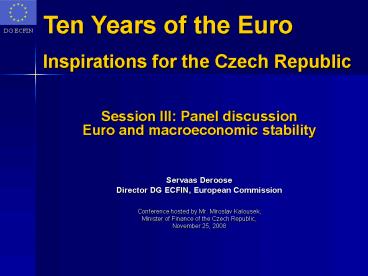Session III: Panel discussion Euro and macroeconomic stability - PowerPoint PPT Presentation
1 / 16
Title:
Session III: Panel discussion Euro and macroeconomic stability
Description:
Domestic: from overheating to hard-landing? Financial: Are financial systems resilient? ... in demand pressures and overheating risks, especially in fixed XR ... – PowerPoint PPT presentation
Number of Views:37
Avg rating:3.0/5.0
Title: Session III: Panel discussion Euro and macroeconomic stability
1
Ten Years of the Euro Inspirations for the Czech
Republic
- Session III Panel discussionEuro and
macroeconomic stability - Servaas Deroose
- Director DG ECFIN, European Commission
- Conference hosted by Mr. Miroslav Kalousek,
Minister of Finance of the Czech
Republic,November 25, 2008
2
Outline
- Assessing macroeconomic stability
- Domestic from overheating to hard-landing?
- Financial Are financial systems resilient?
- External Are external positions sustainable?
- Lessons from EMU_at_10 for future members
- Challenges
- Policy requirements
- Conclusion
3
Real convergence is advancing but remains a
long-term challenge
GDP per capita in 2007 (in PPS, EU100) and
average change, 2004-2007
4
Growth is slowing considerably due to global and
domestic factors (in , y-o-y)
5
Price level convergence but also demand pressures
12-month average inflation (in , y-o-y)
6
Financially-driven convergence large capital
inflows and extension of external balance sheets
7
Very rapid financial deepening from a low base
(less pronounced amongst floaters)
- Domestic credit growth (in of GDP)
8
Large external imbalances (especially in
fixers)
Balance on current account (in of GDP)
9
Fiscal positions External constraints seem to
matter for fiscal performance General government
balance and government debt (in of GDP 2007)
10
Exchange rate developments vs. euro, monthly
averages (index numbers, Jan 2007 100)
11
Lessons from EMU_at_10 for future euro area members
(1 - challenges)
- Price stability equilibrium real appreciation
complicates inflation control shorter history
of anti-inflation policy and lower credibility
conflict between fiscal and monetary authorities
wage catching up - Effective adjustment capacity (incl.
stabilisation) - To deal with shocks without exchange rate
instrument (but nominal exchange rate flexibility
acts also as shock propagator, hence less cost
of giving up the XR instrument) - Relatively more frequent and persistent common
shocks with asymmetric impact (exchange rates,
terms of trade, shifting comparative
advantages) asymmetric shocks still possible
(see Spain, Ireland, ) - Correction of large current account imbalances
may require long and painful disinflation
processes if coupled with stagnating productivity - EMU and financial integration help efficient
resource allocation and allow for longer
adjustment periods, but managing credit booms can
be a challenge (already well before euro
adoption) - Do not lose sight of long-term challenges
sustain high potential growth, in a context of
ageing, globalisation (with more rapid shifts in
comparative advantages)
12
Lessons from EMU_at_10 for future euro area members
(2 policy needs)
- Improved budgetary control to reduce the risk of
fiscal policy pro-cyclicality budgetary
frameworks in NMS are less developed and
assessing cyclical component even more
challenging - Sustainability of public finances
- Quality of public finances bias towards current
expenditure in NMS - Flexible and integrated goods and factor markets
- More efficient use of labour resources
(participation rates, structural unemployment,
skill mismatches) - Business environment and investment climate
(innovation, FDI, education, favour entry /exit
of firms) - Growth-enhancing use of capital inflows NMS are
receiving huge inflows , included EU funds
utilisation has differed a lot across NMS - Effective supervision and regulation of financial
markets NMS experience accelerated financial
development
13
Fiscal policy
- Fiscal policy has to balance multiple challenges
- need for well-targeted public spending
(infrastructure, education and RD) - vs
- fiscal policy key to rein in demand pressures and
overheating risks, especially in fixed XR regimes - Preventing imbalances may require substantial
surpluses of longer periods - Quality of public finances (pro-growth
priorities)
14
Coping with financial deepening and credit growth
- Vigilance to prevent the build-up of imbalances
and vulnerabilities - Prudential and administrative measures
- Raise minimum capital adequacy ratio
- Strengthen loan-loss provisioning
- Mandatory loan-to-income or loan-to-value limits
- Strengthen supervisory framework
- Improvements in credit registers
- Strengthening risk management, expand stress
testing - Harness cross-border supervision
15
Structural policy implications
- Boost external competitiveness
- Ensure favourable business environment and
investment climate - Encourage innovation and entrepreneurship to
maintain competitiveness and move up the
value-added chain - Move toward high value-added and fast-growing
sectors - Sectoral composition of exports
- Productivity growth in the tradables sector
- Enhance internal economic adjustment
- NMS will have to manage underlying structural
divergences for some time - Ensure functioning of goods, services and labour
markets - labour mobility, skill development wage
flexibility - wage setting in line with productivity gains
- Entrepreneurship, etc.
16
Conclusion
- Catching-up is proceeding but accompanied by
varying imbalances - Euro adoption readiness more important than
timing - Ability to cope with country-specific adjustment
needs - Adequate preparation in fiscal, structural and
prudential domains - Short-term challenges deal with fall-out from
the financial crisis manage orderly unwinding of
imbalances among the fixers, keep progress
towards convergence on track for the floaters































